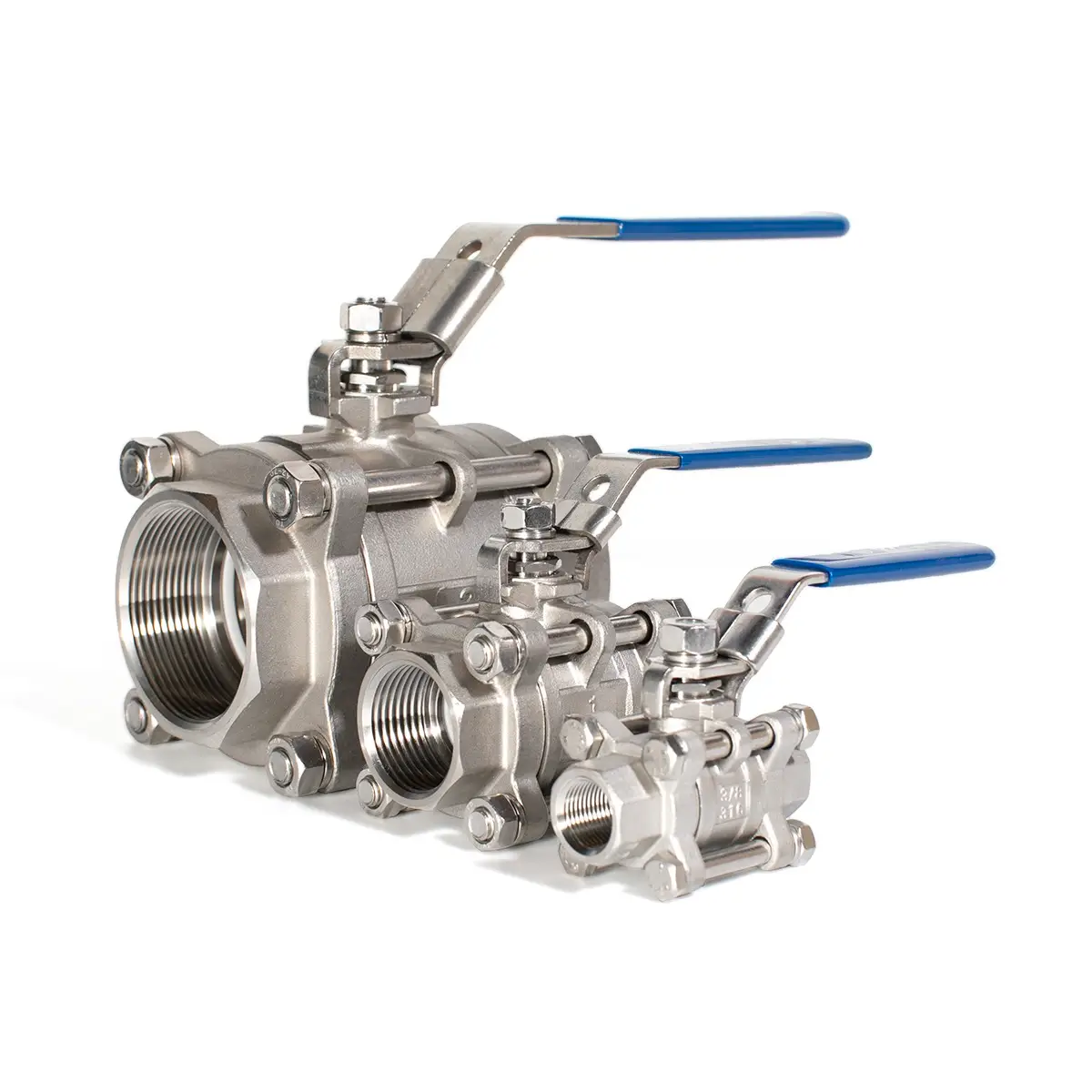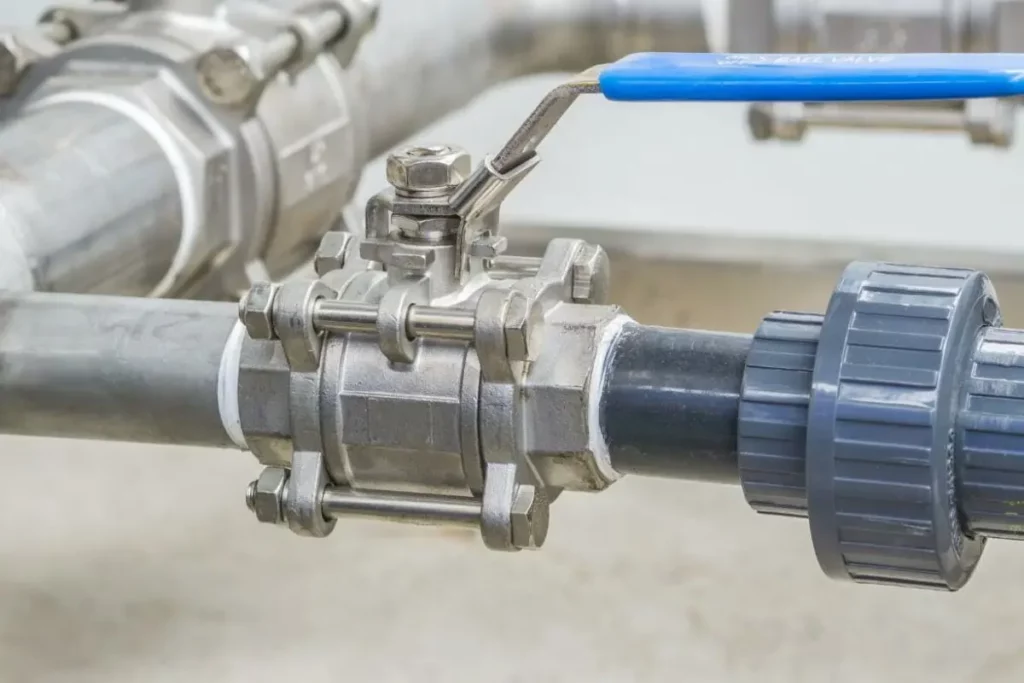As gatekeepers of productivity and safety, ball valves bear the responsibility of regulating flow, withstanding high pressures and temperatures, and offering reliable shut-off capabilities. Despite their significance, maintenance on ball valves is often overlooked, leading to decreased efficiency, potential system failures, and costly downtime.
In this guide, we will explore the importance of ball valve maintenance in industrial piping systems, empowering industry professionals with the knowledge and techniques needed to keep these indispensable components in peak condition.
What is a Ball Valve?
A ball valve is a quarter-turn valve that uses a hollow, spherical ball to control the flow of liquids or gases through a pipeline. The valve design consists of a spherical ball with a central bore or hole. When the ball valve is in the open position, the bore aligns with the pipeline, allowing the medium to flow freely. Conversely, when the valve is closed, the ball is rotated 90 degrees, positioning the bore perpendicular to the pipeline, effectively blocking the flow.
Ball valves offer a range of benefits. They are renowned for their excellent shut-off capabilities, offering tight sealing and minimal leakage when closed. Their quarter-turn operation provides quick and easy control, allowing for efficient adjustment of flow rates. With their robust construction, ball valves can withstand high pressures and temperatures, making them suitable for a wide range of industrial applications.

Why is Ball Valve Maintenance Important?
Ball valve maintenance plays a crucial role in ensuring the long-term performance, reliability, and safety of industrial piping systems. Here are some key reasons why maintaining ball valves is of paramount importance:
- Optimal Performance
Over time, valves can experience wear and tear, accumulation of debris, or buildup of deposits, which can impede their functionality. By conducting routine inspections, cleaning, and lubrication, you can prevent these issues and ensure that the valves operate smoothly, allowing for precise control of flow rates and reducing the risk of system disruptions. - Extended Lifespan
By addressing potential issues promptly and replacing worn-out components, maintenance helps prolong the lifespan of ball valves, reducing the need for frequent replacements and associated costs. - Energy Efficiency
Valves that are not functioning optimally or have leaks can lead to energy wastage. By ensuring tight shut-off capabilities and minimising leakage, maintenance efforts help to optimise energy usage, resulting in cost savings and reducing the environmental impact of operations. - Safety and Reliability
Regular inspections and maintenance of ball valves help identify potential safety hazards, such as leaks or valve malfunctions, which, if left unaddressed, can result in accidents, equipment damage, or even catastrophic incidents. - Compliance with Regulations
Many industries are subject to stringent regulations and standards governing safety, environmental protection, and operational efficiency. Proper maintenance of ball valves ensures compliance with these requirements and mitigates risks associated with non-compliance.
Ball Valve Maintenance Procedure
To ensure the optimal performance and longevity of ball valves, a comprehensive maintenance regimen is essential. By implementing a diligent approach to ball valve maintenance, you can safeguard the integrity of their industrial piping systems, prevent unexpected disruptions, and unlock the full potential of these vital components. Below is a step-by-step procedure for ball valve maintenance:
Regular cleanings
Regular cleanings are vital for keeping ball valves free from debris, sediment, and contaminants that can hinder their performance. Cleaning procedures typically involve disassembling the valve, removing any built-up deposits, and thoroughly cleaning all components. In general, it is recommended to perform cleaning at least once a year for ball valves in normal operating conditions. However, in more demanding environments or applications with higher contamination levels, more frequent cleaning may be necessary, such as every six months or even quarterly.
Valve lubrication
Proper lubrication is paramount to the smooth operation of ball valves and prevents excessive wear on its components. Lubricating the valve stems, seals and other moving parts reduces friction and helps maintain tight shut-off capabilities. Make sure to select the appropriate lubricant for the specific valve materials and application to ensure compatibility and reliable performance.
Routine inspections
These inspections involve checking for regular wear and tear, corrosion, leaks, and other potential issues that may affect the valve’s functionality. The frequency of inspections can vary based on the application, with high-pressure and high-cycle applications often requiring more frequent assessments. During a routine inspection:
- Check the tightness of bolts, nuts, and hardware to prevent valve shifting or failure.
- Inspect for corrosion or mineral buildup that can weaken the valve structure or impede proper sealing.
- Carefully examine for leaks around seals, gaskets, and connections and perform leak tests if necessary.
- Verify smooth operation during opening and closure, addressing any sticking or resistance.
- Ensure accurate position indication for proper process control and safety.
- Assess ventilation and air filtration systems to prevent harmful buildup.
- Promptly replace or repair worn-out or damaged components.
Scheduled plant shutdowns
Scheduled plant shutdowns provide an opportune time to conduct more in-depth maintenance procedures on ball valves. These planned shutdowns allow for comprehensive inspections, repairs, or replacements as needed.
Regular testing
Testing procedures can include pressure testing, leak detection, and flow testing. These tests help identify any performance deviations, potential leaks, or inadequate shut-off capabilities.
Storage
Proper storage of ball valves is essential, particularly during periods of non-use or when valves are kept as spares. Valves should be protected from environmental factors such as moisture, extreme temperatures, and corrosive agents. Adequate storage practices, such as applying protective coatings, ensuring proper sealing, and storing valves in a clean and dry environment, help preserve their condition and prevent deterioration.
In the realm of ball valve maintenance, these procedures form the pillars of a comprehensive maintenance program. By adhering to these guidelines, you can nurture the lifeline of ball valves, ensuring their longevity, efficiency, and contribution to the seamless operation of your industrial systems.
Factors that Impact Ball Valve Lifespan
- Actuation
The frequency of operation and the type of the actuation mechanism, such as manual, pneumatic, electric or hydraulic, can affect the longevity of a ball valve. - Design
Factors like the internal construction, sealing mechanism, and flow characteristics of a ball valve play a role in determining its longevity and ability to withstand various operating conditions. - Serviceability
Easy access to maintenance, availability of spare parts, and clear documentation for repairs and replacements contribute to the extended lifespan of a ball valve. - Temperature and pressure rating
Adhering to the recommended temperature and pressure limits ensures that the ball valve operates within its specified range, preventing excessive stress and potential premature failure. - Media
Corrosive, abrasive, or viscous media can accelerate the wear and deterioration of valve components, necessitating careful material selection and additional protective measures to extend the valve’s lifespan. - Valve Materials
While plastic valves offer cost-effectiveness, they are not suitable for high pressure and high-temperature environments and tend to have a shorter lifespan compared to their metal counterparts. As such, it is crucial to verify that the valve body and seal materials are compatible with the specific media flowing through the valve to ensure optimal performance and durability. - Source
The reliability and expertise of the manufacturer or supplier influences the quality of the ball valve, ensuring higher-quality materials, precise manufacturing, and adherence to industry standards, all of which contribute to a longer lifespan.
John Valves – Your Reliable Partners in Ball Valve Maintenance
At John Valves, we understand the importance of maintaining optimal performance for your ball valves. As the experts in valve reconditioning and repair, we are here to ensure that your equipment operates at its best. With our skilled team and years of experience, we are equipped to handle the repair, maintenance and reconditioning of a wide range of valves, regardless of their make, type, or size.
Our commitment to quality is unwavering. Each valve repair or reconditioning service we undertake is carried out in strict accordance with Australian industry guidelines. You can trust that our certified technicians work diligently in our state-of-the-art workshops in Australia, utilising sophisticated repair facilities and the latest techniques.
When you choose John Valves, you choose a partner that keeps your satisfaction on top of everything. Our focus on delivering reliable and guaranteed service means you can rely on us for all your ball valve maintenance and repair needs.

